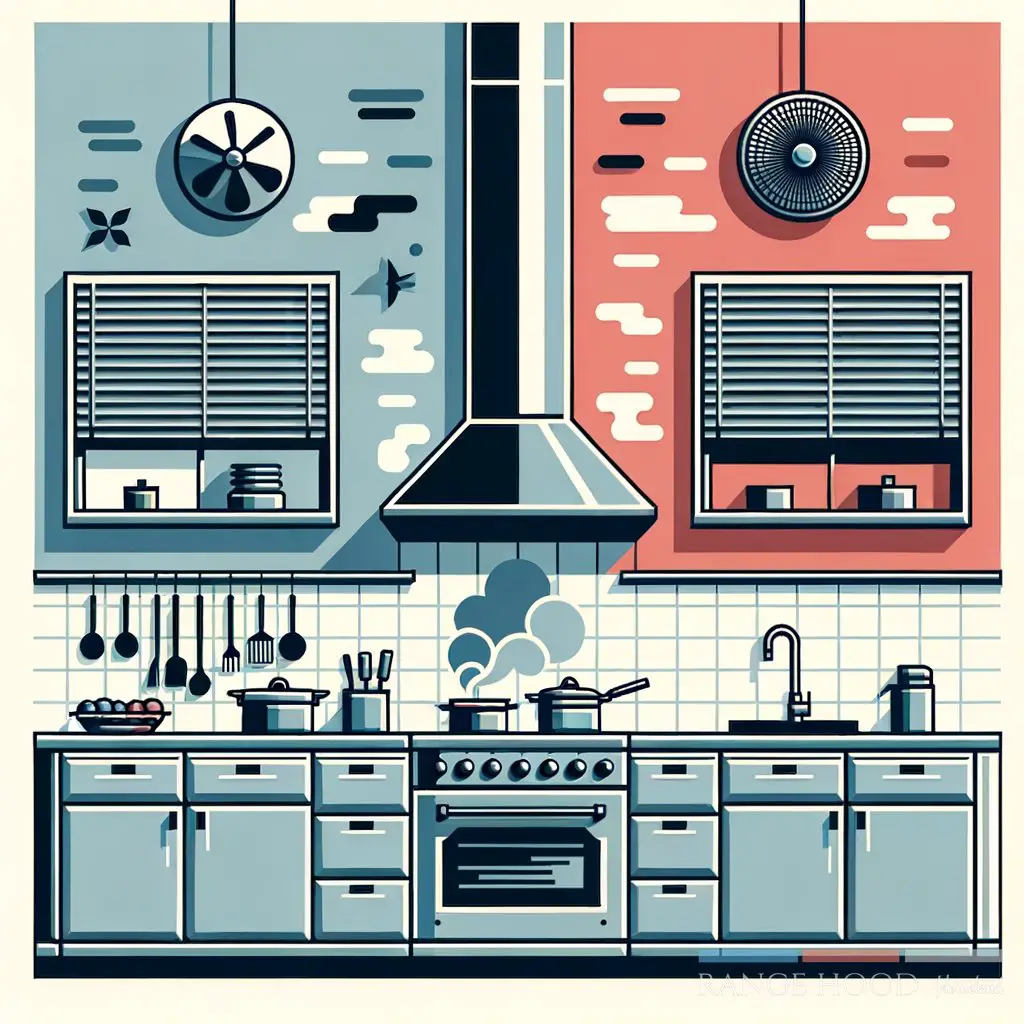Ever been caught in the crossfire of a heated debate about the best way to keep your kitchen smelling fresh while cooking up a storm? I sure have, and let me tell you, opinions vary more than you’d think.
It’s a topic that culinary enthusiasts get passionate about, almost as much as they do when discussing the best range hoods for ensuring a pleasant kitchen environment. For those curious about how range hoods come into play, check out this insightful guide on the top range hoods.
In this post, we’ll dive into the essentials of kitchen ventilation and how you can effectively reduce cooking odors.
If you are a visual learner, check out this video titled ‘Eliminate Fried Food Smells & Make Your Home Smell Amazing!’
Key takeaways
- Investing in a quality range hood can massively improve air quality.
- Maintenance of filters is crucial for ongoing efficiency.
- Choosing ducted ventilation offers superior odor elimination.
- Natural ventilation methods serve as useful supplements.
How can you keep your kitchen smelling fresh?
In the bustling heart of your home, the kitchen, savory aromas are a sign of delicious meals. However, lingering cooking smells can quickly turn from delightful to overwhelming.

Effective kitchen ventilation is key to maintaining a fresh atmosphere. Below, we explore the best strategies and technologies designed to tackle these persistent odors and ensure your kitchen remains a pleasant space for both cooking and socializing.
1. Invest in a high-quality range hood
A powerful range hood is your first line of defense against cooking odors. It works by sucking up smoke, grease, and odors, venting them outside your home.
Investing in a high-quality model ensures better efficiency and longer-lasting performance. The right type, whether it’s an island-mount, wall-mounted, or under-cabinet, depends on your kitchen’s layout and your cooking habits.
It’s not just about removing odors; it’s also about maintaining a clean, grease-free kitchen environment. Ensuring your range hood has the right CFM (cubic feet per minute) rating for your stove’s size and type is crucial.
For more insights, explore options in the best range hoods guide to find a model that suits your specific needs.
2. Regular maintenance of filters
Your range hood’s effectiveness is directly linked to its maintenance, especially the filters. These filters trap grease and odor; hence, when clogged, they can’t perform efficiently.

Washing or replacing them regularly is crucial for maintaining optimal ventilation and reducing odors.
Moreover, clean filters improve air quality and ensure your range hood operates quietly and efficiently. Check out these tips for maintaining your kitchen ventilation system for more details on how to keep your filters in top-notch condition.
3. Consider ducted ventilation systems
Ducted systems are king when it comes to eliminating kitchen odors. By venting to the outside, they carry away smoke, grease, and smells better than their ductless counterparts.
If your kitchen’s layout allows for it, a ducted system can be a game-changer in keeping your space odor-free.
Installation can be more involved and potentially more costly, but the benefits are worth it. For guidance on installation, head over to how to install a ducted range hood.
The fresh air and clean kitchen environment they provide make ducted systems a top choice for serious cooks.
4. Use charcoal filters for ductless hoods
If you’re using a ductless range hood, don’t despair. Equipping it with charcoal filters can significantly improve odor reduction.
These filters absorb smoke and odors, purifying the air before recirculating it back into the kitchen. While not as efficient as ducted systems, they’re a viable option for apartments or homes where ducted ventilation isn’t feasible.
Replacing these filters regularly is key to keeping them effective. As they can’t be cleaned and reused, having a few spares on hand is always a good idea.
Learn more about the benefits and maintenance of charcoal filters in the comprehensive guide to installing a ductless range hood.

5. Open windows and doors
Sometimes, the simplest solutions are the most effective. Opening windows and doors while cooking can help disperse cooking odors and introduce fresh air into the kitchen.
This natural ventilation works wonders, especially for quick cooking sessions.
“While the installation of a high-quality range hood might be seen as an upfront investment, its ability to improve air quality, eliminate odors, and minimise grease buildup transforms it into a valuable asset for any kitchen, optimizing both safety and comfort.”
Pairing this with your kitchen ventilation system creates an even more effective odor-elimination strategy. While not always possible due to weather or pollution, when the opportunity arises, letting fresh air in can make a big difference.
For more kitchen cooling tips, check out how to cool down a kitchen.
COSMO COS-63190S Wall Mount Range Hood

COSMO COS-63190S Wall Mount Range Hood
More kitchen ventilation tips
Beyond the fundamentals of kitchen ventilation systems and habits, there are several other practices that can contribute to a fresher kitchen environment. These tips can serve as supplementary measures alongside your main ventilation strategy, optimizing indoor air quality and minimizing unwanted odors.
- Cook with lids on: Keeping pots covered as much as possible helps contain odors and steam.
- Clean as you cook: Wiping up spills and splatters promptly prevents odors from setting in.
- Use an air purifier: An air purifier can help remove cooking odors and other indoor pollutants.
- Boil cinnamon sticks or citrus peels: Creating a natural, pleasant scent can help mask cooking odors temporarily.
- Regularly clean your kitchen: Floors, countertops, and appliances can harbor odors if not cleaned regularly.
Dos and don’ts
In the quest for optimal kitchen ventilation and odor control, there are some practices that are beneficial and others that are best avoided.
| Do | Don’t |
|---|---|
| Use the highest fan setting when cooking strong-smelling foods | Leave lingering dishes and trash that can contribute to bad odors |
| Clean spills and splatters immediately | Block air vents or filters, reducing ventilation efficiency |
| Open windows when weather and safety permit | Ignore the maintenance schedule for your ventilation system |
Following these guidelines will enhance your ventilation efforts.
In summary, effective kitchen ventilation combines technology, good habits, and regular maintenance.
Advantages and disadvantages of effective kitchen ventilation
When considering whether to upgrade or optimize your kitchen ventilation system, it’s important to weigh the pros and cons. Effective kitchen ventilation can significantly improve your cooking experience and indoor air quality, but it does come with certain considerations.
Pros
- Improves indoor air quality: Removes harmful pollutants and reduces the risk of respiratory issues.
- Eliminates cooking odors: Keeps your home smelling fresh and clean.
- Prevents grease buildup: Reduces the risk of fire hazards and makes cleaning easier.
- Enhances home value: A well-ventilated kitchen is a desirable feature for potential homebuyers.
Cons
- Installation costs: Upgrading to a high-efficiency system can be expensive.
- Energy consumption: Powerful range hoods and ventilation systems can increase energy bills.
- Maintenance requirements: Regular cleaning and filter replacement is necessary to maintain efficiency.
Opinion
As someone who’s no expert in kitchen design but has seen a fair share of kitchen setups, I believe the value of a good ventilation system can’t be overstated. It’s one of those elements you don’t always notice when it’s working perfectly, but its absence can significantly impact your comfort and health.
From what I’ve gathered, especially after reading about the benefits of installing a range hood, a properly chosen and maintained kitchen ventilation system can be a game-changer in maintaining a pleasant cooking environment. While the initial setup might require some research and investment, the long-term gains in terms of air quality and cleanliness seem well worth the effort.
On the flip side, I understand the constraints of space, budget, and technical feasibility that many face, especially in urban settings where modifications can be limited. It’s here I see the value in seeking out creative, less traditional solutions to kitchen ventilation.
From air purifiers to strategic window use, there are ways to improve your situation without complete overhauls. Ultimately, it’s about finding a balance that works for your specific needs and constraints.
Frequently asked questions (FAQ)
Can cooking without a range hood be harmful?
Cooking without a range hood can lead to a buildup of harmful pollutants like carbon monoxide and nitrogen dioxide, especially when cooking with gas. These pollutants can aggravate respiratory conditions and impair indoor air quality.
Using a range hood effectively removes these contaminants and promotes a healthier living environment.
How usually should I replace charcoal filters in a ductless range hood?
Charcoal filters in ductless range hoods should be replaced every three to six months, depending on your cooking frequency. If you cook usually or produce a lot of smoke and odors, you might need to replace them more frequently.
Regular replacement ensures the filters continue to effectively absorb and neutralize kitchen odors.
Is it necessary to have my kitchen ventilation system professionally installed?
While some smaller, ductless range hoods can be a DIY project, for more complex systems, especially ducted ones, professional installation is recommended. This ensures that the ventilation is installed correctly, securely, and in compliance with local building codes.
Professional installation can also help optimize the system’s efficiency and performance.
Final thoughts
In wrapping up this comprehensive guide to kitchen ventilation, it’s clear that the right setup can significantly improve your culinary experience by keeping your space odor-free and your air quality high. From choosing the right range hood to understanding the importance of maintenance and the role of natural ventilation, we’ve covered a lot of ground.
Remember, the goal is to create a kitchen that’s not only a joy to cook in but also a healthy and pleasant space for everyone in your household.
What’s your biggest takeaway on reducing cooking odors and ensuring effective kitchen ventilation? Did I cover everything you wanted to know? Let me know in the comments section below; I read and reply to every comment. If you found this article helpful, share it with a friend, and check out my full blog for more tips and tricks on effective kitchen ventilation.
Thanks for reading, and here’s to a fresher, cleaner kitchen!















